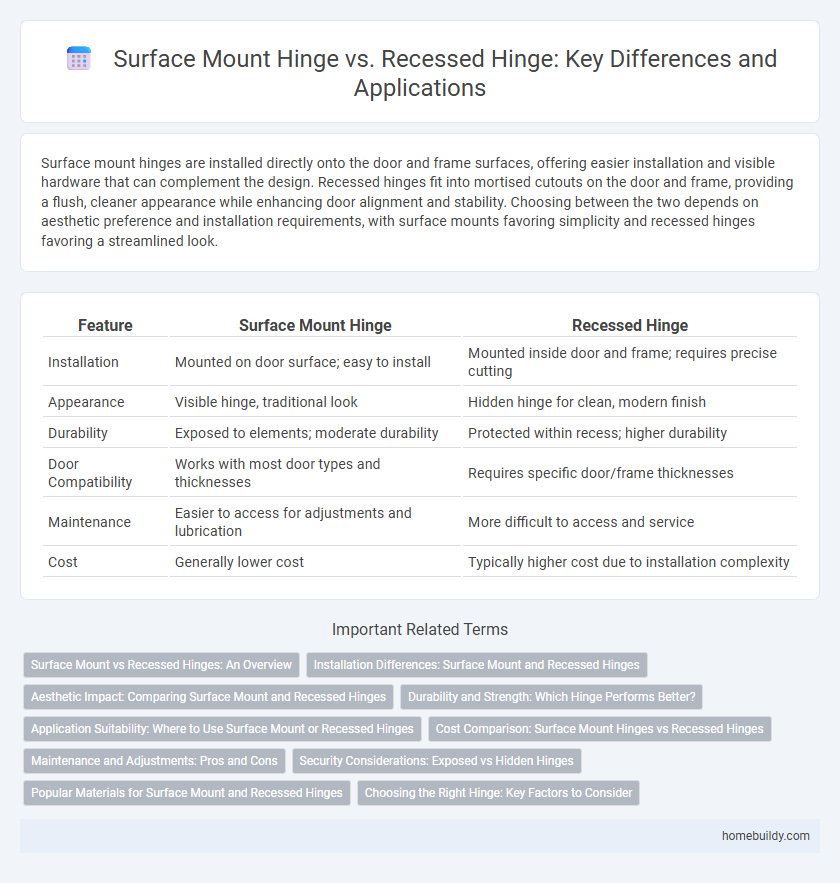Surface mount hinges are installed directly onto the door and frame surfaces, offering easier installation and visible hardware that can complement the design. Recessed hinges fit into mortised cutouts on the door and frame, providing a flush, cleaner appearance while enhancing door alignment and stability. Choosing between the two depends on aesthetic preference and installation requirements, with surface mounts favoring simplicity and recessed hinges favoring a streamlined look.
Table of Comparison
| Feature | Surface Mount Hinge | Recessed Hinge |
|---|---|---|
| Installation | Mounted on door surface; easy to install | Mounted inside door and frame; requires precise cutting |
| Appearance | Visible hinge, traditional look | Hidden hinge for clean, modern finish |
| Durability | Exposed to elements; moderate durability | Protected within recess; higher durability |
| Door Compatibility | Works with most door types and thicknesses | Requires specific door/frame thicknesses |
| Maintenance | Easier to access for adjustments and lubrication | More difficult to access and service |
| Cost | Generally lower cost | Typically higher cost due to installation complexity |
Surface Mount vs Recessed Hinges: An Overview
Surface mount hinges attach directly onto the door and frame surfaces, offering easy installation and adjustment without requiring door or frame modifications. Recessed hinges fit into mortised cavities within the door and frame, providing a flush, concealed look but demanding precise cutting and alignment. Choosing between surface mount and recessed hinges depends on aesthetic preferences, installation complexity, and the desired door functionality.
Installation Differences: Surface Mount and Recessed Hinges
Surface mount hinges attach directly to the door and frame surface, requiring minimal preparation and offering quick installation. Recessed hinges necessitate precise cutouts or mortises in the door and frame to fit flush, demanding more cutting and skill for proper alignment. The choice between surface mount and recessed hinges significantly impacts installation time, tools needed, and the door's aesthetic finish.
Aesthetic Impact: Comparing Surface Mount and Recessed Hinges
Surface mount hinges provide a visible hardware element that can complement modern or industrial design styles, while recessed hinges offer a cleaner, minimalist aesthetic by being hidden from view. Recessed hinges are often preferred for high-end cabinetry and furniture where seamless surfaces are desired, enhancing the overall sleekness of the piece. The choice between surface mount and recessed hinges directly influences the visual impact of doors and cabinets, making hinge selection crucial for design coherence.
Durability and Strength: Which Hinge Performs Better?
Surface mount hinges offer robust durability due to their full bearing on the door surface, ensuring strong support for heavy doors and frequent use. Recessed hinges, while providing a sleek and flush appearance, often experience reduced strength because a portion of the hinge is embedded into the door or frame, potentially compromising load-bearing capacity. In terms of long-term performance, surface mount hinges typically outperform recessed hinges in strength and resistance to wear under heavy stress conditions.
Application Suitability: Where to Use Surface Mount or Recessed Hinges
Surface mount hinges are ideal for applications requiring easy installation and visible hardware, commonly used on lightweight cabinet doors and interior room doors where aesthetics are less critical. Recessed hinges fit flush within the door and frame, making them suitable for exterior doors and heavy-duty applications that demand a clean, streamlined appearance and enhanced security. Choosing between surface mount and recessed hinges depends on the door material, weight, and desired visual impact.
Cost Comparison: Surface Mount Hinges vs Recessed Hinges
Surface mount hinges typically cost less than recessed hinges due to easier installation and reduced labor requirements. Recessed hinges demand precise mortising, increasing both labor time and installation complexity, which raises overall expenses. Budget-conscious projects often favor surface mount hinges to minimize upfront and maintenance costs.
Maintenance and Adjustments: Pros and Cons
Surface mount hinges offer easier maintenance and quick adjustments as they are fully visible and accessible without removing door panels, making lubrication and tightening convenient. Recessed hinges, embedded within the door and frame, provide a cleaner look but complicate maintenance due to limited accessibility, requiring partial disassembly for adjustments or repairs. While surface mount hinges allow straightforward upkeep minimizing downtime, recessed hinges may offer better alignment stability but demand higher effort and precision during maintenance tasks.
Security Considerations: Exposed vs Hidden Hinges
Surface mount door hinges are fully exposed, making them more susceptible to tampering and forced removal, which can compromise door security. Recessed hinges are partially or fully concealed within the door frame, significantly reducing the risk of unauthorized hinge removal and enhancing overall protection. Choosing recessed hinges is particularly advantageous in high-security environments where preventing hinge tampering is critical.
Popular Materials for Surface Mount and Recessed Hinges
Surface mount hinges commonly utilize stainless steel and brass for their durability and corrosion resistance in exterior applications. Recessed hinges often feature zinc alloy and steel with a powder-coated finish, providing strength and a flush fit essential for interior doors. Both hinge types benefit from materials chosen to balance aesthetics, load capacity, and environmental exposure.
Choosing the Right Hinge: Key Factors to Consider
Choosing the right door hinge involves evaluating factors such as installation type, aesthetics, and durability. Surface mount hinges are easier to install and provide visible support, while recessed hinges offer a cleaner look with concealed hardware but require precise mortising. Consider the door material, weight, and frequency of use to select a hinge that balances functionality and design for long-lasting performance.
surface mount hinge vs recessed hinge Infographic

 homebuildy.com
homebuildy.com